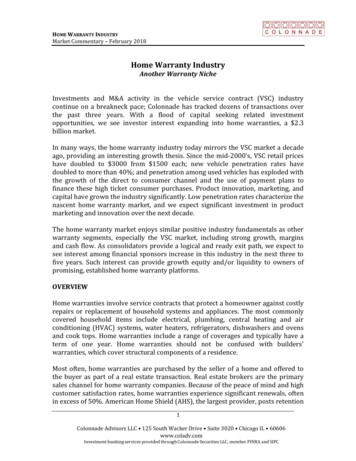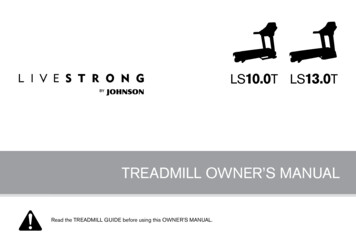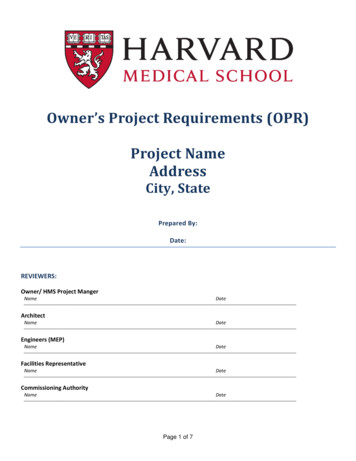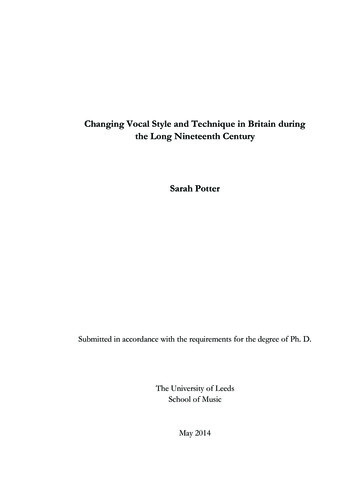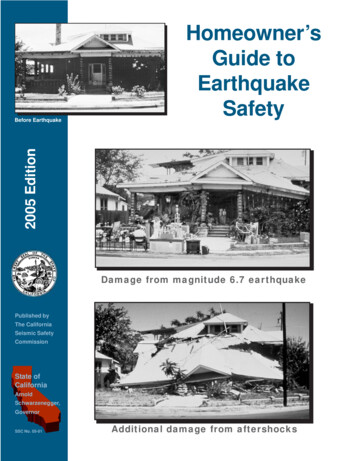
Transcription
2005 EditionBefore EarthquakeHomeowner’sGuide toEarthquakeSafetyDamage from magnitude 6.7 earthquakePublished byThe CaliforniaSeismic SafetyCommissionState ofCaliforniaArnoldSchwarzenegger,GovernorSSC No. 05-01Additional damage from aftershocks
This 2005 Edition of the Homeowner’s Guide to EarthquakeSafety replaces the 2002 Edition on July 1, 2005.Publishing InformationThe Homeowner’s Guide to Earthquake Safety was developed andpublished by the California Seismic Safety Commission. The guide wasprepared for publication by the staff of The Collaborative for DisasterMitigation, San Jose State University, One Washington Square, SanJose, CA 95192-0082. It was distributed under the provisions of theLibrary Distribution Act and Government Code Section 11096.Copyrighted 2005 by the California Seismic Safety CommissionAll rights reservedLegislationThis guide has been developed and adopted by the California SeismicSafety Commission as required by Assembly Bill 2959, authored byAssemblyman Johan Klehs (Chapter 1499, Statutes of 1990), andAssembly Bill 200, authored by Assemblyman Dominic Cortese (Chapter699, Statutes of 1991).Ordering InformationCopies of this booklet are available from the California Seismic SafetyCommission, 1775 Creekside Oaks Drive, Suite 100, Sacramento, CA95833. To order call (916) 263-5506 or download via our website athttp://www.seismic.ca.gov/sscpub.htmOn the cover:Taken in Coalinga, California, the pictures of this single family homeshow the destruction caused by the Coalinga Earthquake on May 2,1983. The 6.7 magnitude earthquake inflicted severe damage to theunreinforced masonry porch, forcing the occupants to evacuate.Numerous aftershocks occurred within the next few days, causingportions of the already weakened structure to collapse.iiThe Homeowner’s Guide to Earthquake Safety
CONTENTSPagePageINTRODUCTION.1OTHER EARTHQUAKE-RELATEDCONCERNS.28Your Home and the Law.2Recommendations.3Summary of Major California Laws.4Property Tax and Insurance.5Examples of Damage to Single FamilyHomes.6Unreinforced Masonry Chimneys.28Foundations.30Homes with Unique Designs.31NATURAL GAS SAFETY.32EARTHQUAKE MAPS OF CALIFORNIA.7GETTING THE WORK DONE.34Damaging Earthquakes in California.7Major Earthquake Faults in California.8Simplified Earthquake Shaking Potential Mapfor California.9GEOLOGIC HAZARDS.36WHAT TO DO DURING AN EARTHQUAKE.39ADDITIONAL RESOURCES.10WHAT TO DO BEFORE AN EARTHQUAKE.40EARTHQUAKE WEAKNESSES.11Unbraced Water Heaters.12Home Not Anchored to Foundation.14Weak Cripple Walls.16Pier and Post Foundations.18Unreinforced Masonry Foundations.20Homes Built on Steep Hillsides.22Unreinforced Masonry Walls.24Rooms over Garages.26WHAT TO DO AFTER AN EARTHQUAKE.42RESOURCE ORGANIZATIONS.44RESIDENTIAL EARTHQUAKE HAZARDSREPORT.47SAMPLE TAX EXCLUSION FORM.49The Homeowner’s Guide to Earthquake Safetyiii
ACKNOWLEDGMENTSSeismic Safety CommissionLucille M. Jones, Ph.D., Chair, SeismologyHon. Richard Alarcon, State Senate(Chris Modrzejewski)Hon. Carol Liu, State Assembly(Donald Manning)Lawrence T. Klein, UtilitiesMark Church, Local GovernmentLinden Nishinaga, P.E., City GovernmentCelestine Palmer, InsuranceAndrew A. Adelman, P.E., Cities/BuildingOfficialStan Moy, A.I.A., Architecture and PlanningDaniel Shapiro, S.E., Structural EngineeringVacant, Mechanical EngineeringBruce R. Clark, Ph.D., GeologyVacant, County GovernmentVacant, Emergency ServicesDonald R. Parker, Vice Chairman, FireProtectionJimmie R. Yee, Social ServicesVacant, Soils EngineeringSeismic Safety Commission StaffRichard McCarthy, Executive DirectorRobert AndersonKaren CoganHenry ReyesHenry SepulvedaFred Turner, Project CoordinatorSue CelliRebecca RomoCollaborative for Disaster Mitigation StaffGuna Selvaduray, Ph.D., Executive DirectorPatrick Chong, WebmasterThe Commission gratefully acknowledgesthe assistance of the following:American Red CrossAmerican Society of Home InspectorsAssociation of Bay Area GovernmentsBuilding Education CenterCalifornia Association of RealtorsCalifornia Building OfficialsCalifornia Council of the American Institute ofArchitectsCalifornia Geological SurveyCalifornia Real Estate Inspection AssociationCalifornia Governor’s Office of EmergencyServicesCity of Los AngelesEarthquake Engineering Research InstituteHumboldt Earthquake Education CenterInternational Code CouncilSBCSan Diego Association of GovernmentsSouthern California Association of GovernmentsSouthern California Association of ResidentialRetrofit ProfessionsSouthern California Gas Company/SempraStructural Engineers Association of CaliforniaCommittee on Earthquake Safety Issues for GasSystemsDisclaimer: The effects, descriptions, recommendations, andsuggestions included in this document are intended to improveearthquake preparedness; however, they do not guarantee thesafety of an individual or a structure. The Seismic SafetyCommission takes responsibility for the inclusion of material inthis document. The State of California, the Seismic SafetyCommission, and all contributors to this document do notassume liability for any injury, death, property damage, loss ofrevenue, or any other effect of an earthquake.Crystal Carrera, Administrative AssistantivThe Homeowner’s Guide to Earthquake Safety
INTRODUCTIONEarthquakes, especially major ones, aredangerous, inevitable, and a fact of life inCalifornia. Sooner or later another “big one” willoccur.Earthquakes:Occur without warningCan be deadly and extremely destructiveCan occur at any timeAs a current or potential owner of a home*, youshould be very concerned about the potentialdanger to not only yourselves and your loved ones,but also to your property.The major threats posed by earthquakes are bodilyinjuries and property damage, which can beconsiderable and even catastrophic.Most of the property damage caused byearthquakes ends up being handled and paid forby the homeowner.This Booklet is designed to assist you in filling outthe Residential Earthquake Hazards Report (Seepage 47) when you sell your home.This booklet is also a good start to beginstrengthening your home against earthquakedamage.It describes:Common weaknesses that can result in yourhome being damaged by earthquakes, andSteps you can take to correct theseweaknesses.There are no guarantees of safety duringearthquakes, but properly constructed andstrengthened homes are far less likely to collapseor be damaged during earthquakes. The CaliforniaSeismic Safety Commission advises you to act onthe suggestions outlined in this booklet and makeyourself, your family, and your home safer.Earthquakes have caused over 55 billion inlosses in California since 1971.Large earthquakes in or near major urbancenters in California will disrupt the localeconomy and can disrupt the economy of theentire State.However, proper earthquake preparation of yourhome can:Save livesReduce injuriesReduce property damageAs a homeowner, you can significantly reducedamage to your home by fixing a number of knownand common weaknesses.The Homeowner’s Guide to Earthquake Safety*For the purpose of this document, “home” includessingle family residences, duplexes, triplexes, andfourplexes.1
YOUR HOME AND THE LAWCalifornia State Law requires theseller to:Inform the buyer about known homeweaknesses (See EarthquakeWeaknesses, beginning on page 11).Strap the water heater, reducing thechance of it falling during an earthquakeand possibly causing gas and water lines tobreak.Deliver a copy of this booklet to the buyer ifthe home was built before 1960 (Your realestate agent is required to give the seller acopy of this booklet).Deliver to buyers a Natural HazardsDisclosure form (See page 4). Thedisclosure will tell buyers whether the homeis in an Earthquake Fault Zone or in aSeismic Hazard Zone (See page 38)This Booklet:Describes the most common weaknessesthat can cause damage to homes, in theevent of an earthquake.Enables the seller to meet the State Lawrequiring this booklet be given to everybuyer of homes built before 1960.Enables the seller to disclose to the buyerthe typical earthquake weaknesses inhomes built before 1960.Provides the homeowner with basicinformation about finding and fixingearthquake-related weaknesses in thehome.Provides general information aboutearthquake risks and directions for findingmore information on earthquake safety.Complete the Residential EarthquakeHazards Report, to be provided to thebuyer (See page 47).California State Law does not requirethe seller to:Hire someone to evaluate your home.Strengthen your home before selling it.2The Homeowner’s Guide to Earthquake Safety
RECOMMENDATIONS.If You Are SellingIf You Are BuyingBefore you sell your house, the following stepsare recommended:Before you agree to buy a house, consider thefollowing recommendations:If you list your house for sale through a realestate broker or agent, give the agent thecompleted disclosure form (See page 47)as soon as practical. Your agent can givethe booklet and the form to the buyer foryou.Have a certified home inspector, licensedbuilding contractor, architect, or engineerinspect the house and give you an opinionregarding existing earthquake weaknessesand an estimate of costs to strengthenthese weaknesses.You are not required to hire someone toanswer the questions on the disclosureform.You are not required to remove siding,drywall, or plaster to answer the questions.You are not required to fix the weaknessesbefore you sell your home.However, if you wish, you may getassistance from a certified home inspector,or a licensed contractor, architect, orengineer.Keep a copy of the form, signed by thebuyer, as evidence that you have compliedwith the earthquake disclosurerequirement.Consider the location of the home: Is it in ornear an Earthquake Fault Zone or in anarea where it might be damaged by alandslide, liquefaction, or a tsunami? Youmay wish to hire a licensed geotechnicalengineer and/or engineering geologist tocheck the stability of the land under thehouse.Negotiate the cost of strengthening, if anyis required, with the seller. The law doesnot require either you or the seller tostrengthen the home, but if these weaknesses are not fixed, you may find thatrepair costs after a damaging earthquakecan amount to more than your equity in thehouse.You may find that you will get a better price foryour house if you strengthen earthquakeweaknesses before you sell.The Homeowner’s Guide to Earthquake Safety3
SUMMARY OF MAJOR CALIFORNIA LAWSRELATED TO SEISMIC SAFETYFull wording of all California codes is available at: http://www.leginfo.ca.gov.Delivering this guideSellers of homes built before 1960, with one to fourunits of conventional light-frame construction,must deliver to the buyer, “as soon as practicablebefore the transfer,” a copy of The Homeowner’sGuide to Earthquake Safety (this booklet) anddisclose certain earthquake deficiencies accordingto Government Code, Section 8897.1 to 8897.4.The seller’s real estate agent must provide theseller with a copy of this booklet to give to thebuyer. This is also specified in Government Code,Section 8897.5.Water heater bracingAll water heaters are required to be anchored orstrapped to resist falling during an earthquake.The seller must certify to the potential buyer thatthe water heater is properly braced in accordancewith Health and Safety Code, Section 19211.Disclosing weaknessesSellers of real property must disclose knowndefects and deficiencies in the property—includingearthquake weaknesses and hazards—toprospective buyers in accordance with Civil Code,Section 1102 and following sections.Disclosing natural hazardsSellers of real property must disclose whether theproperty is within any of the seven mapped naturalhazard areas, including the earthquake fault,potential landslide and potential liquefaction areas.The required Natural Hazards Disclosure Form can4be found in Civil Code, Section 1103 andfollowing sections. When filled out, this statutoryform will reveal whether the home is within amapped geologic, flood or hazard area.Earthquake faultsThe Alquist-Priolo Earthquake Fault Zoning Actprohibits building for human occupancy astrideactive faults. Public Resources Code, Section2621 and following sections, requires sellers ofexisting residences to disclose to potential buyerson a Natural Hazards Disclosure Form if theproperty is located in a designated fault zone.Landslide and liquefactionThe Seismic Hazards Mapping Act requires thestate to prepare maps of the zones in Californiamost susceptible to landslide and liquefactionhazards during earthquakes. Public ResourcesCode, Section 2694 and following sections, statesthat sellers must disclose to buyers, on a NaturalHazards Disclosure Form, whether the property isin such a zone, after the map for that area hasbeen issued officially.Publishing this guideThe Seismic Safety Commission is required todevelop, adopt, update, and publish TheHomeowner’s Guide to Earthquake Safetycontaining information on geologic and seismichazards, explanations of structural andnonstructural earthquake hazards, andrecommendations for mitigating these hazards,as required by the Business and ProfessionsCode, Section 10149.The Homeowner’s Guide to Earthquake Safety
PROPERTY TAX AND INSURANCEProperty Tax Reappraisal ExclusionEarthquake InsuranceCalifornia law allows homeowners to strengthentheir homes with approved seismic strengtheningtechniques without the improvement beingincluded in reappraisals that usually raise theproperty value and the tax owed, according to theRevenue and Tax Code, Section 74.5.Earthquake insurance is typically not part of yourhomeowner insurance policy. All insurancecompanies that sell residential property insurancein California are required by law to offerearthquake insurance to homeowners when thepolicy is first sold and every two years afterward.If you make an addition, such as a swimming poolor a new den to your home, your property tax billwill increase. But a strengthening project to helpyour home resist earthquakes will not add to yourproperty taxes.The cost of the earthquake policy you are offeredis based on a number of factors, including yourhome’s location, age, construction type, and value.One thing to consider would be to compare theexpected damage versus the deductible that isapplicable to your policy. You may wish to consulta licensed civil or structural engineer for morespecific information on your potential for damage.To receive the exclusion you must file a claim formwith your county assessor. The work must also beapproved as appropriate seismic strengthening byyour local building department.A sample form from the County of Santa Clara isattached on page 49. This form may vary bycounty.Each homeowner should consider his/herindividual risk factors and then weigh the cost ofearthquake coverage against the benefits. TheCalifornia Earthquake Authority (CEA) website hasan online calculator to help estimate your premiumbased on your ZIP Code, insured value, dwellingtype, and desired coverage and deductible.The California Earthquake Authority is required toprovide, and the insurance companies are requiredto disclose the availability of, discounts onearthquake insurance premiums for older homesthat have been strengthened to resist earthquakedamage. For more information, contact yourinsurance agent, who can also help you locate anearthquake insurer and estimate your annualpremium.California Earthquake Authority:www.EarthquakeAuthority.comCalifornia Department of Insurance:www.insurance.ca.govThe Homeowner’s Guide to Earthquake Safety5
Figure 1 - San Fernando Earthquake, Feb. 9,1971 Severely damaged split level 1 and 2 storywood frame dwelling. The one story portiondropped about 3 feet.FEMA News PhotoPacific Fire Rating BureauEXAMPLES OF DAMAGE TOSINGLE FAMILY HOMESRobert A. Eplett, OESDane Golden, FEMA News PhotoFigure 4 - Northridge Earthquake, Jan. 17, 1994Chimney Collapse - common type of damage tounreinforced masonry.FEMAGuna SelvadurayFigure 5 - San Simeon Earthquake, Dec. 22, 2003This home slid two feet off its foundation due toinadequate nailing of walls to its sill plates.Figure 2 - Loma Prieta Earthquake, Oct. 17, 1989Home moved off of its foundation and was considereda total loss.Figure 3 - Northridge Earthquake, Jan. 17, 1994Single family residence damaged due to failure ofmultiple elements.6Figure 6 - San Simeon Earthquake, Dec. 22, 2003The collapsed porch was not adequately attached tothis single family residence.The Homeowner’s Guide to Earthquake Safety
EARTHQUAKE MAPS OFCALIFORNIADAMAGING EARTHQUAKES IN CALIFORNIAFigure 7—Earthquake history. California hasexperienced many damaging earthquakes in thepast two centuries. The sizes of the dots on thismap indicate the relative magnitude of earthquakesthat occurred at these locations.EUREKA, 1954,1980CAPE MENDOCINO,1992OROVILLE, 1975Seismic Zones in California. All of Californialies within Seismic Zone 3 or 4. There are fourzones in the U.S.A., ranging from 1 to 4; thehigher the number the higher the earthquakedanger. Stronger construction standards forbuildings in Zones 3 and 4 have been adopted inthe Uniform Building Code.TAHOE, 1966WINTERS-VACAVILLE, 1892SANTA ROSA, 1969NAPA VALLEY, 2000SAN FRANCISCO, 1906OWENS VALLEY, 1980CHALFANT VALLEY, 1986MORGAN HILL, 1984LOMA PRIETA, 1989OWENS VALLEY, 1872COALINGA, 1983SAN SIMEON, 2003HECTOR MINE, 1999KERN COUNTY, 1952SAN FERNANDO, 1971SANTA BARBARA, 1925ZONE 3ZONE 4NORTHRIDGE,1994SIERRA MADRE,1991LONG BEACH, 1933WHITTIER NARROWS,1987FORT TEJON,1857LANDERS/BIGBEAR, 1992PALM SPRINGS,1986IMPERIAL VALLEY,1940, 1979, 1987Source: California Geological Survey, 1986; Earthquake History of the U.S., U.S. Department of Commerce and Interior, 1982;Records of California Office of Emergency Services; compiled and revised by California Seismic Safety Commission, 2004;International Code Council, Uniform Building Code 1997 Edition.The Homeowner’s Guide to Earthquake Safety7
MAJOR EARTHQUAKE FAULTS IN CALIFORNIAFigure 8 - Earthquake Faults - Map showingmajor earthquake faults in California on whichearthquakes are most likely to occur.EurekaSan FranciscoSanAndreasFaultSanta BarbaraLos AngelesFor a more detailed map, includingnames of faults, go to:www.seismic.ca.gov/hog.htmSan DiegoMap courtesy of California Geological Survey. Fault locations modified from seismic sources used in Revised 2002 CaliforniaProbabilistic Seismic Hazard Maps.8The Homeowner’s Guide to Earthquake Safety
SIMPLIFIED EARTHQUAKE SHAKING POTENTIALMAP FOR CALIFORNIAFigure 9 - Earthquake Shaking Potential Map - Thismap shows the relative intensity of ground shaking anddamage in California from anticipated futureearthquakes.Please note:Expected damages in California in thenext 10 years exceed 30 billion.EurekaThree-quarters of our nation’searthquake losses will be in California.Efforts to reduce the losses fromearthquakes have already proveneffective.SacramentoSan FranciscoSan JoseFresnoIncreasing intensityRegions near major, activefaults. These will on averageexperience stronger earthquakeshaking more frequently.Regions distant from known,active faults. These willexperience lower levels ofshaking less frequently.Los AngelesLong BeachSan DiegoFor a full color version go to:www.seismic.ca.gov/hog.htmData source: California Seismic Safety Commission, California Geological Survey, Governor’s Office of EmergencyServices, and United States Geological Survey, April, 2003, Earthquake Shaking Potential for California, CaliforniaSeismic Safety Commission Publication No. 03-02.The Homeowner’s Guide to Earthquake Safety9
ADDITIONAL RESOURCESThere are many additional resources available. Some are web sites and some arebooks or pamphlets.The California Seismic Safety Commission has created a webpage thatprovides links to other sites that are appropriate for homeownersinterested in improving the earthquake safety of their homes.Visit www.seismic.ca.gov/hog.htmFEMA also provides a wide variety of information suitable for thehomeowner, including the availability of, and registration for, federaldisaster aid programs after a damaging earthquake or other disasters.Visit www.fema.gov10The Homeowner’s Guide to Earthquake Safety
EARTHQUAKE WEAKNESSESThe earthquake weaknesses identified in this section, if not corrected, can result inone or more of the following:Injury to occupantsSevere damage to your homeBroken gas and utility linesFires from broken gas linesDamage to floors, walls, and windowsDamage to the contents in the houseDamage to the foundationsPlease remember that:Retrofitting before an earthquake is relatively cheap.Doing major structural repairs to your home after an earthquake is veryexpensive.Sometimes the damage is extensive enough to require the entire house tobe demolished.After an earthquake, there is usually a shortage of available licensedcontractors and engineers in the impacted area, because of the suddenhigh demand for their services.An appropriate seismic retrofit will reduce damage and save you money.Please consult your local Building Department and/or a licensed architect orengineer for more detailed information.The Homeowner’s Guide to Earthquake Safety11
IDENTIFYWEAKNESSESContents DamageUnbraced Water HeatersGovernor’s Office of Emergency ServicesThe ProblemIf water heaters are not properly braced, they cantopple over during an earthquake causing:Broken gas lines and gas leaksWater heaterFires causing major damage to homesBroken water lines and floodingHow to IdentifyIs the water heater free-standing?Are there straps or other types of restraintssecuring the water heater?Are there straps or restraints bolted to theAre there flexible pipes for water and gasconnected to the water heater?Figure 10 - The unbraced water heater inthis home fell during an earthquake; theresulting fire destroyed the home.Guna Selvaduraystuds?RememberReplacing a water heater after an earthquakecan cost more than 500.Repairing fire damage and flooding damagecan cost several thousand dollars, including theentire cost of your home!There are many different ways of strapping awater heater. One example is shown on thenext page. (See page 13)Check with your local Building Department fordetails of local requirements.Know where your main water valve is so thatyou can shut it off if you have a water leak.Know where your main gas valve is so that youcan shut it off if you hear or smell a gas leak.(See page 32)12Figure 11 - This unstrapped water heatertipped over during the 1984 Morgan HillEarthquake. Fortunately gas and waterlines were not ruptured.The Homeowner’s Guide to Earthquake Safety
Brace Water HeatersHOW-TOWater heaters must be braced (securely attached) to the studs in a wall. California law requires waterheaters to be braced at the time of sale, or when a new water heater is installed.The SolutionThere are many solutions – all relativelyinexpensive.Purchase and install a strap kit orbracing kit from your local hardwarestore. Be sure the kit is certified bythe State Architect.If wood blocking is used, itmust be attached to studs.SheetrockOther options include:Have a licensed plumber strap yourwater heater according to code.FlexiblepipesUse metal tubing or heavy metalstrapping and lag screws andwashers to secure the water heaterto the wall studs.The gas and water lines should also haveflexible pipes. These are safer than rigidpipes during an earthquake.StrapsWATERHEATERBe sure to check the straps once a year.They may come loose due to vibrations,or other causes.How-to ResourcesYour local home improvement storeHow to Brace Your Water Heater, City of LosAngeles, Department of Building & Safety,Information Bulletin #P/PC 2002-003, June 14,1999.Guidelines for Earthquake Bracing of ResidentialWater Heaters, Department of General Services,Division of State Architect, August 11, 2004.Figure 12: One Method of Water Heater Bracing. Strapsand screws visible with water heater in a garage installation.You may need to add wood blocking.How to Secure Your Water Heater, Governor’sOffice of Emergency Services, 2003.Comparison of Cost: Preventing vs. Repairing Earthquake DamageProject Cost 20 to 200Cost to Repair after an Earthquake 500 to total value of home (if completely destroyed).The Homeowner’s Guide to Earthquake Safety13
IDENTIFYWEAKNESSESHome Not Anchored to FoundationOffice of Emergency ServicesThe ProblemHouses that are not bolted to the foundation canmove off their foundations during earthquakes.How to IdentifyGo down into the crawl space – the areabetween the first floor and the foundation – tofind out if your house is bolted to its foundation.Look for the heads of anchor bolts that fastenthe sill plate – the wooden board that sitsdirectly on top of the foundation – securely tothe foundation. (See Figure 14a, page 15)You should be able to see the large nuts,washers, and anchor bolts, installed at leastevery 4 to 6 feet along the sill plate. Steelplates are sometimes used instead of anchorbolts. (See Figure 14b, page 15)RememberFigure 13 - This home wasn’t bolted and slid off itsfoundation. Sometimes the damage can be so bad thathouses have to be demolished.If your home has no foundation, or an oldconcrete foundation, see page 30.It is very expensive to lift a house, and place itback on its foundation.Homes moving off their foundations can causegas lines to rupture, which in turn can result infires.Slab FoundationsSome homes are built directly on concrete slabs. These houses do not have crawl spacesand cripple walls.Nearly all homes with slab foundations that were originally built to code will have anchorbolts or straps.However, if the house is not bolted to the slab, you have an earthquake weakness.Newer homes generally have anchor bolts or straps.If you have an unfinished garage, you may be able to see the anchor bolts.You are not required to remove siding, drywall or plaster to determine if your house hasanchor bolts.14The Homeowner’s Guide to Earthquake Safety
Anchor entsDamageNonstructuralHazardsContentsDamageWall studsThe SolutionDrill holes through the sill plate into the foundationand install anchor bolts. (See Figure 14a)Floor joistsFlooringIf there is not enough room to drill, you can attachsteel plates to hold the sill plate to the foundation.(See Figure 14b)Anchor bolts have to be installed properly for them tobe effective.CRAWLSPACEConcretefoundationYou must obtain the proper permits from your localBuilding Department before beginning work.Tops ofanchor boltsSill PlateFigure 14aWall studFloor joistsFlooringCRAWLSPACEConcretefoundationSteel platesHow-to ResourcesFigure 14bDetailed information for do-it-yourselfers orengineers can be found in the International ExistingBuilding Code, published by the International CodeCouncil.Publication: How You Can Strengthen Your Homefor the Next Big Earthquake in the Los AngelesArea, City of Los Angeles, Department of Building& Safety, October 2001.Figure 14 —Anchor bolts or steel plates. A home’s crawlspace may be formed by a cripple wall (see next page fordescription) between the foundation and the floor joists or thefloor joists may rest directly on the sill plate. In either case,you should be able to see the heads of anchor bolts or steelplates installed at appropriate intervals. These fixtures fastenthe sill plate to the foundation.Comparison of Cost: Preventing vs. Repairing Earthquake DamageProject Cost 250 to 5,000Cost to Repair after an Earthquake 25,000 to total value of home (if completely destroyed).The Homeowner’s Guide to Earthquake Safety15
IDENTIFYWeakWEAKNESSESStructuralDamageContents DamageNonstructuralHazardsCripple WallsOffice of Emergency ServicesThe ProblemWooden floors and stud walls are sometimes builton top of an exterior foundation to support a houseand create a crawl space. (See Figure 17, page 17)These are called cripple walls and they carry theweight of the house.During an earthquake, these walls can collapse ifthey are not braced to resist horizontal movement.If the cripple wall fails, the house may shift or fall.How to IdentifyGo under the house through the crawl space, tosee if there are any cripple walls.If there are cripple walls, check to see if theyare braced.There should be plywood panels adequatelynailed to the studs OR there should be diagonalwood sheathing. (See Figure 16)Figure 15 - Damage to home due to cripplewall failure.If you have neither of these, the cripple wallsare probably insufficiently braced or unbraced.FloorjoistsHorizontal or vertical wood siding is notstrong enough to brace cripple walls.First floorRememberIt is very expensive to lift a house, repairthe cripple wall, and put it back on itsfoundationCripple wallDiagonalsheathingFigure 16 - Diagonal Sheathing. Common in older homes.16The Homeowner’s Guide to Earthquake Safety
Strengthen Cripple WallsHOW-TOThe SolutionFloor joistsPlywood, or other wood products allowed by code,should be nailed to the studs.Plywood panelsFirst floorThe following are important:SidingType of wood product usedCripplewallPlywood thicknessNail size and spacingStudsDo not cover vents.Consult your local Building Department for permitrequi
unreinforced masonry porch, forcing the occupants to evacuate. Numerous aftershocks occurred within the next few days, causing portions of the already weakened structure to collapse. ii The Homeowner’s Guide to Earthquake Safety This 2005 Edition of the Homeowner’s Guide to Ear



